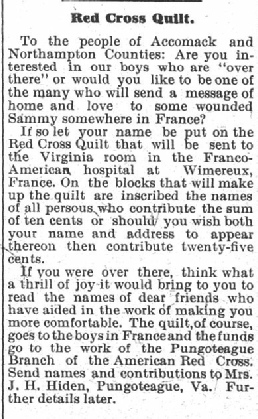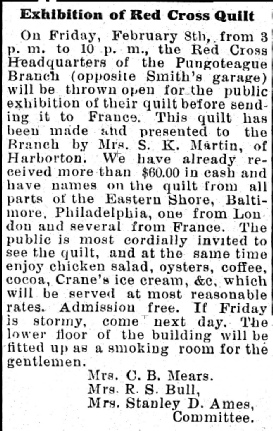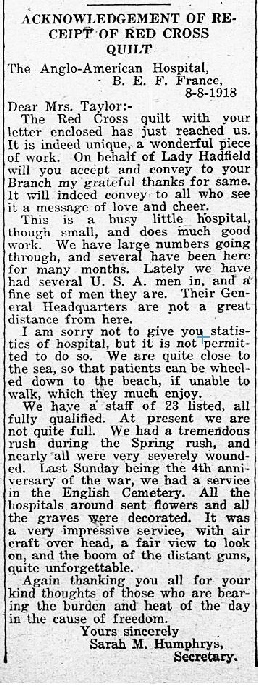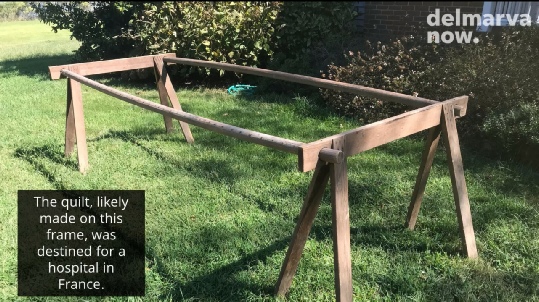



PUNGOTEAGUE QUILT
AMERICAN RED CROSS QUILT
Version 6.01
13 February 2025
David March © 2019
STORY OF THE QUILT
On 5 January 1918, this notice appeared on page 5 of the Peninsula Enterprise.
January 1918, this notice appeared on page 5 of the Peninsula Enterprise.
Less than a month later, on 2 February the paper included an invitation to see the completed quilt on display at the Red Cross Headquarters of the Pungoteague Branch.

The quilt was made by Ella Susan, Mrs Smith Kendall Martin (1858-1950) of Harborton, Accomack County, Virginia, and presented to Pungoteague Branch of the Eastern Shore Chapter of the American Red Cross. Ella’s husband had farmed in Pungoteague but by the turn of the century he was running a lumber business in Pungoteague.
The names on the quilt were written by Dion George Agathoin (1857-1920); Canadian by birth, he had come to the Eastern Shore in the 1870s. It seems he had an aptitude for careful hand work as he was awarded a premium at the Grange Fair, Accomack in September 1885 for ‘scroll work’. Around the time the quilt was made, he was a bookkeeper for a lumber company, possibly Smith Kendall Martin’s business.
The names to be inscribed on the quilt were collected by Nellie B, Mrs J H Hiden (1868-1964). Nellie was the wife of Dr Joseph Hart Hiden, a physician in Pungoteague for over thirty years.
The newspaper report of 2 February indicates that $60.00 had already been received. A further $75.00 had been pledged by the time the quilt was complete. The organizing committee comprised Henrietta Adalaide, Mrs C B Mears (1876-1961), Lois Emma, Mrs R S Bull (1877-1949) and Albertine French, Mrs Stanley D Ames (1893-1982).
It is not known whether President Wilson and his wife personally contributed the 50 cents for their names and address.
Despite the reference in the press cutting above to the “Franco-American Hospital”, according to the message in block F10 of the quilt, it was intended to be hung in the Virginia Room of the Anglo-American Hospital at Wimereux, France. This is thought to refer to the British Red Cross Hospital No 5, also known at Lady Hadfield’s Hospital.
On 21 September 1918, this lettter appeared on page 4 of the Peninsula Enterprise.
September 1918, this lettter appeared on page 4 of the Peninsula Enterprise.
No evidence has been found of how the quilt comes to be part of the collection of the Imperial War Museum, London, UK.
Coda
The interest generated in the present day communities of the Eastern Shore was followed up by Carol Vaughn of The Daily Times and resulted in a lengthy article in the online paper delmarva now.
This investigation brought to light Mrs Martin’s quilting frame!
Webster Martin, 85, of Harborton is the great-grandson of the quilt's maker. The Martin family has been in Virginia virtually since the colony's founding.
"She was Ella Susan Smith from Sluytkill Neck," across the creek from Harborton, Martin said of his ancestor, of whom he has many memories from his youth.
Mrs. Martin's quilting frame — likely the one she used for the Pungoteague Quilt, among others — is still in the family, having been stored in the attic of an outbuilding at Rose Lawn, the family home in Harborton.
From there, it was taken to Webster Martin's house, also in Harborton, for storage.
"I've had it up in my barn loft for years," Martin said.
Courtesy of Carol Vaughn, delmarva now,
Click on the image to read the whole story.
Images courtesy of Newspapers.com

